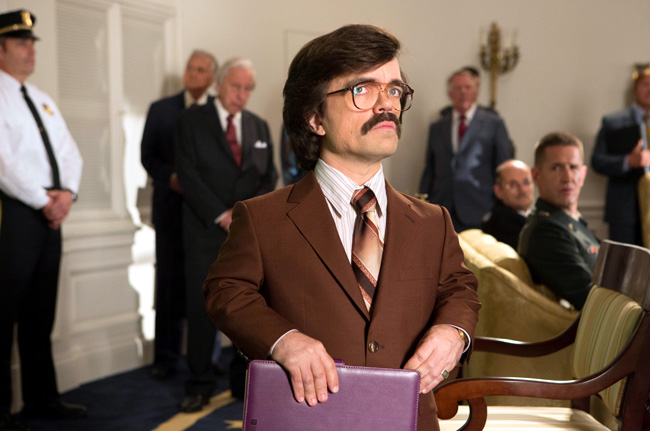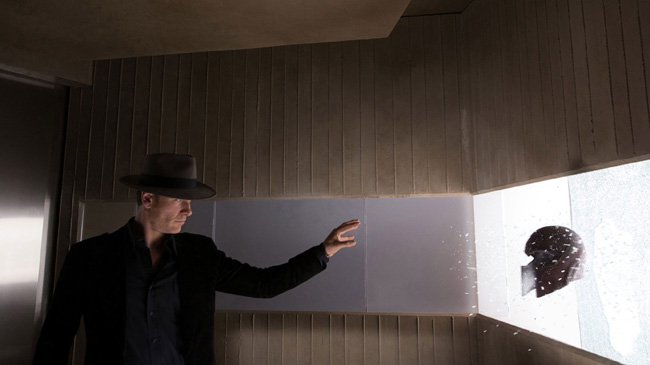CHICAGO – In anticipation of the scariest week of the year, HollywoodChicago.com launches its 2024 Movie Gifts series, which will suggest DVDs and collections for holiday giving.
‘X-Men: Days of Future Past’ Dares to Richly Invest in Story First, CGI Second
 Rating: 4.0/5.0 |
CHICAGO – After a string of superhero movie disappointments in recent memory, last month “Captain America: The Winter Soldier” renewed our faith in Hollywood blockbusters once again. Just 7 weeks later, can “X-Men: Days of Future Fast” impress us again?
Not only does it deliver, but it manages to pull together the tastiest ingredients of its strong subject matter and dish up one of the best films in its franchise history. The film – with its $200 million production budget – has already earned back $36 million in its first day of release to nearly 4,000 domestic theatres.

Photo credit: Alan Markfield, Marvel, 20th Century Fox
The new X-Men film follows 6 others in the last 14 years – one, in fact, as recent as 10 months ago. These 6 previous films have been hit or miss. “The Wolverine” in 2013 was a lukewarm hit, “X-Men: First Class” was a hit in 2011, we saw a mega miss in 2009 with “X-Men Origins: Wolverine,” a miss in 2006 with “X-Men: The Last Stand,” a hit in 2003 with “X2: X-Men United” and a hit in 2000 with “X-Men”.
While so many memorable characters exist in Marvel’s X-Men universe, many of the films have either been directly focused on The Wolverine (even in the film’s name) or primarily in the story line. “X-Men: Days of Future Past” stays true to the theme of respecting The Wolverine’s importance, but also brings the spotlight onto so many other mutants.
More clearly defined than any previous X-Men film and even better than most other superhero movies in general, it is this X-Men outing that figures out how to deliver the important message of “you’re unique but not alone”. This X-Men film even accomplishes a feat that most superhero films can’t: honoring the hardcore comic-book fans while equally allowing the layperson who isn’t invested in the franchise to fall in love with it for the first time.
In addition to The Wolverine, now it is “The Hunger Games” star Jennifer Lawrence who especially shines most brightly in the plot’s center with her Jekyll and Hyde role as the good Raven and the evil Mystique. And it’s not just because she’s basically naked and covered in an enhanced blue suit the whole film. I’ll delve more into her critical role below.

Photo credit: Alan Markfield, Marvel, 20th Century Fox
Much of this story is told through Hugh Jackman’s eyes while time traveling to the past. While his claws (bone in this movie rather than the typical metal) are a bonus, Wolverine’s true mutation is his ability to heal. He’s the only mutant who can survive Kitty Pryde’s (Ellen Page) power of time traveling as far back as he needs to go.
While he has mastered so many cinematic elements to make this film a hit – namely focusing on story first and complementing it with special effects – director Bryan Singer’s surface accomplishments are underscored by his subtle abilities. He’s able to use style and sound, for instance, to create authentic environments for the constantly changing time periods.
While it’s tiresome to see a superhero movie predictably round up a group of bandits for the purpose of banding together yet again, “X-Men: Days of Future Fast” interestingly does it twice: once in the present and again in the past.
The Wolverine serves as the leader. It’s entertaining to watch him get the older Professor X (Patrick Stewart) to kiss and make up with his current enemy and previous friend Magneto (Ian McKellen). Then when traveling back in time, The Wolverine must do it again with the younger versions of themselves: Charles Xavier (James McAvoy) and Erik Lehnsherr (Michael Fassbender). In the past, Hank (or Beast when mutated) is the only one who’s staying with Charles Xavier as he fights his double-edged sword of being able to walk when taking a drug but losing his brain power when he’s out of the wheelchair.

Photo credit: Alan Markfield, Marvel, 20th Century Fox
The fascinating question of X-Men in general is always which one you’d rather be and which power you’d want to sport around throughout life. The introduction of multiple versions of Charles Xavier is an even more complicated question. Would you rather walk but have no telepathy or would you rather have telepathy from the confines of a wheelchair?
What interests me the most about “X-Men: Days of Future Fast” is how much I care to focus, talk about and remember its richly complicated story. Blockbuster films like this so often blow so much of their budget on special effects but think of the plot as an afterthought. “X-Men: Days of Future Fast” reverses that often-made mistake by investing heavily in its writing and allowing its CGI to perfectly complement it.
This is a tricky decision to make – each film is a business and our industry has become addicted to eye candy – but it’s an even more challenging mission to execute once you’ve dared to make the choice. Rather than its primary focus, special effects were always designed to be and always should be a complement to a film’s strong story. But many big-budget films fall victim to trying to make a weak story look good on the surface while there’s no substance underneath. It’s a death trap to think people won’t care that a script has been thinly developed if they get to see a couple of hours Hollywood movie magic.
I’m fine with “X-Men: Days of Future Fast” taking so much inspiration from Gene Roddenberry. The film even pays homage to the “Star Trek” creator by showing an old TV with a scene from the original series with William Shatner. Without Roddenberry’s vision of time travel and the space-time continuum, so much sci-fi today wouldn’t exist. And without him, the basis of this film’s leaps from the present to the past couldn’t have been so cohesive.

Photo credit: Alan Markfield, Marvel, 20th Century Fox
While I’d often feel manipulated to see good superheroes team up with the evil ones for a lame reason, here we can actually buy into why Professor X and Magneto join forces. Many humans have never been accepting of the mutants, but the true enemy this time is power-hungry America. Yeah, that sounds just about right.
The villain in “X-Men: Days of Future Fast” isn’t seemingly big and powerful at all. In fact, he’s pretty much as small as it gets. The 4’5” Peter Dinklage (from TV’s “Game of Thrones”) plays Dr. Bolivar Trask. In this film’s past, Trask has cult-like control of American society because he’s the only one who has the weaponized security answer to our government’s gap of not being able to protect our citizens from the mutant threat.
While The Wolverine is always a focal point because of his ability to heal and even though every mutant is unique in his or her one-of-a-kind skill, this film centers on one richly complicated blue mutant.
She’s Raven while on Professor X’s team and Mystique when on Magneto’s. Wherever her allegiance lies, it is her ability to shapeshift that lays the groundwork for Trask’s sentinels. By exploiting her DNA and plugging it into his drones, Trask is able to evolve “Iron Man”-looking robots of the past into truly destructive, shape-shifting machines in the future who are actually able to kill mutants.
As usual, stay after the credits for this non-stop thrill ride. But with 2016’s “X-Men: Apocalypse” already announced and with Jennifer Lawrence (Raven/Mystique), Michael Fassbender (Erik Lensherr/Magneto), Nicholas Hoult (Hank McCoy/Beast) and James McAvoy (Charles Xavier) returning almost exactly 2 years from now, it’s no secret about the excitement that’s coming next.
 | By ADAM FENDELMAN |


